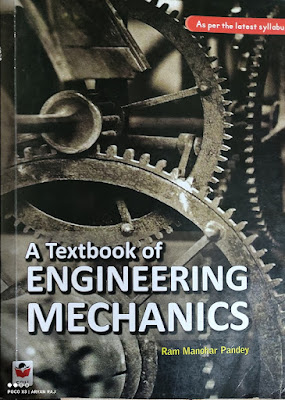𝐎𝐛𝐣𝐞𝐜𝐭𝐢𝐯𝐞 𝐓𝐲𝐩𝐞 𝐐𝐮𝐞𝐬𝐭𝐢𝐨𝐧 ( 𝐄𝐧𝐠𝐢𝐧𝐞𝐞𝐫𝐢𝐧𝐠 𝐌𝐞𝐜𝐡𝐚𝐧𝐢𝐜𝐬)
-: 𝐌𝐨𝐦𝐞𝐧𝐭 𝐨𝐟 𝐚 𝐅𝐨𝐫𝐞 :-
"𝐓𝐰𝐨 𝐞𝐪𝐮𝐚𝐥 𝐚𝐧𝐝 𝐨𝐩𝐩𝐨𝐬𝐢𝐭𝐞 𝐩𝐚𝐫𝐚𝐥𝐥𝐞𝐥 𝐟𝐨𝐫𝐜𝐞𝐬 𝐰𝐡𝐨𝐬𝐞 𝐥𝐢𝐧𝐞𝐬 𝐨𝐟 𝐚𝐜𝐭𝐢𝐨𝐧 𝐚𝐫𝐞 𝐝𝐢𝐟𝐟𝐞𝐫𝐞𝐧𝐭 𝐟𝐨𝐫𝐦 𝐚 𝐜𝐨𝐮𝐩𝐥𝐞 𝐢𝐬
(𝐚) 𝐓𝐫𝐮𝐞
(𝐛) 𝐅𝐚𝐥𝐬𝐞
𝐐.𝟐.
𝐀 𝐜𝐨𝐮𝐩𝐥𝐞 𝐩𝐫𝐨𝐝𝐮𝐜𝐞𝐬
(𝐚) 𝐓𝐫𝐚𝐧𝐬𝐥𝐚𝐭𝐨𝐫𝐲 𝐦𝐨𝐭𝐢𝐨𝐧
(𝐛) 𝐑𝐨𝐭𝐚𝐭𝐢𝐨𝐧 𝐦𝐨𝐭𝐢𝐨𝐧
(𝐜) 𝐂𝐨𝐦𝐛𝐢𝐧𝐞𝐝 𝐭𝐫𝐚𝐧𝐬𝐥𝐚𝐭𝐨𝐫𝐲 𝐚𝐧𝐝 𝐫𝐨𝐭𝐚𝐭𝐢𝐨𝐧𝐚𝐥 𝐦𝐨𝐭𝐢𝐨𝐧
(𝐝) 𝐀𝐥𝐥 𝐭𝐡𝐞 𝐚𝐛𝐨𝐯𝐞
𝐐.𝟑.
𝐓𝐰𝐨 𝐜𝐨𝐮𝐩𝐥𝐞𝐬 𝐰𝐢𝐥𝐥 𝐛𝐚𝐥𝐚𝐧𝐜𝐞 𝐨𝐧𝐞 𝐚𝐧𝐨𝐭𝐡𝐞𝐫 𝐰𝐡𝐞𝐧 𝐭𝐡𝐞𝐲 𝐚𝐫𝐞 𝐢𝐧 𝐭𝐡𝐞 𝐬𝐚𝐦𝐞 𝐩𝐥𝐚𝐧𝐞 𝐚𝐧𝐝 -
(𝐚) 𝐇𝐚𝐯𝐞 𝐞𝐪𝐮𝐚𝐥 𝐦𝐨𝐦𝐞𝐧𝐭𝐬 𝐚𝐧𝐝 𝐭𝐡𝐞𝐢𝐫 𝐝𝐢𝐫𝐞𝐜𝐭𝐢𝐨𝐧 𝐨𝐟 𝐫𝐨𝐭𝐚𝐭𝐢𝐨𝐧 𝐢𝐬 𝐬𝐚𝐦𝐞
(𝐛) 𝐇𝐚𝐯𝐞 𝐮𝐧𝐞𝐪𝐮𝐚𝐥 𝐦𝐨𝐦𝐞𝐧𝐭𝐬 𝐚𝐧𝐝 𝐭𝐡𝐞𝐢𝐫 𝐝𝐢𝐫𝐞𝐜𝐭𝐢𝐨𝐧 𝐨𝐟 𝐫𝐨𝐭𝐚𝐭𝐢𝐨𝐧 𝐢𝐬 𝐨𝐩𝐩𝐨𝐬𝐢𝐭𝐞
(𝐜) 𝐇𝐚𝐯𝐞 𝐞𝐪𝐮𝐚𝐥 𝐦𝐨𝐦𝐞𝐧𝐭𝐬 𝐚𝐧𝐝 𝐭𝐡𝐞𝐢𝐫 𝐝𝐢𝐫𝐞𝐜𝐭𝐢𝐨𝐧 𝐨𝐟 𝐫𝐨𝐭𝐚𝐭𝐢𝐨𝐧 𝐢𝐬 𝐨𝐩𝐩𝐨𝐬𝐢𝐭𝐞
(𝐝) 𝐀𝐥𝐥 𝐭𝐡𝐞 𝐚𝐛𝐨𝐯𝐞
𝐐.𝟒.
𝐀 𝐜𝐨𝐮𝐩𝐥𝐞 𝐢𝐬 𝐚
(𝐚) 𝐒𝐥𝐢𝐝𝐢𝐧𝐠 𝐯𝐞𝐜𝐭𝐨𝐫
(𝐛) 𝐅𝐫𝐞𝐞 𝐯𝐞𝐜𝐭𝐨𝐫
(𝐜) 𝐅𝐢𝐱𝐞𝐝 𝐯𝐞𝐜𝐭𝐨𝐫
(𝐝) 𝐍𝐨𝐧𝐞 𝐨𝐟 𝐭𝐡𝐞 𝐚𝐛𝐨𝐯𝐞
𝐐. 𝟓.
𝐈𝐟 𝐭𝐡𝐞 𝐚𝐫𝐦 𝐨𝐟 𝐚 𝐜𝐨𝐮𝐩𝐥𝐞 𝐢𝐬 𝐝𝐨𝐮𝐛𝐥𝐞𝐝 𝐢𝐭 𝐦𝐨𝐦𝐞𝐧𝐭 𝐰𝐢𝐥𝐥
(𝐚) 𝐁𝐞 𝐡𝐚𝐥𝐯𝐞𝐝
(𝐜) 𝐁𝐞 𝐝𝐨𝐮𝐛𝐥𝐞𝐝
(𝐛) 𝐑𝐞𝐦𝐚𝐢𝐧 𝐭𝐡𝐞 𝐬𝐚𝐦𝐞
(𝐝) 𝐍𝐨𝐧𝐞 𝐨𝐟 𝐭𝐡𝐞𝐬𝐞
𝐐.𝟔.
𝐎𝐧𝐞 𝐨𝐟 𝐭𝐡𝐞 𝐜𝐡𝐚𝐫𝐚𝐜𝐭𝐞𝐫𝐢𝐬𝐭𝐢𝐞𝐬 𝐨𝐟 𝐚 𝐜𝐨𝐮𝐩𝐥𝐞 𝐢𝐬 𝐭𝐡𝐚𝐭 𝐢𝐭 𝐜𝐚𝐧 𝐜𝐚𝐮𝐬𝐞 𝐚 𝐛𝐨𝐝𝐲 𝐭𝐨 𝐦𝐨𝐯𝐞 𝐢𝐧 𝐭𝐡𝐞 𝐝𝐢𝐫𝐞𝐜𝐭𝐢𝐨𝐧 𝐨𝐟 𝐭𝐡𝐞 𝐠𝐫𝐞𝐚𝐭𝐞𝐫 𝐟𝐨𝐫𝐜𝐞
(𝐚) 𝐓𝐫𝐮𝐞
(𝐛) 𝐅𝐚𝐥𝐬𝐞
𝐐.𝟕.
𝐈𝐧 𝐚 𝐜𝐨𝐮𝐩𝐥𝐞 𝐭𝐡𝐞 𝐥𝐢𝐧𝐞𝐬 𝐨𝐟 𝐚𝐜𝐭𝐢𝐨𝐧 𝐨𝐟 𝐭𝐡𝐞 𝐟𝐨𝐫𝐜𝐞𝐬 𝐚𝐫𝐞
(𝐚) 𝐏𝐚𝐫𝐚𝐥𝐥𝐞𝐥
(𝐛) 𝐈𝐧𝐜𝐥𝐢𝐧𝐞𝐝
(𝐜) 𝐍𝐨𝐧𝐞 𝐨𝐟 𝐭𝐡𝐞 𝐭𝐰𝐨
(𝐝) 𝐁𝐨𝐭𝐡 𝐀 𝐚𝐧𝐝 𝐁
𝐐.𝟖.
𝐓𝐡𝐞 𝐮𝐧𝐢𝐭 𝐨𝐟 𝐦𝐨𝐦𝐞𝐧𝐭 𝐨𝐟 𝐚 𝐟𝐨𝐫𝐜𝐞 𝐢𝐬
(𝐚) 𝐍/𝐌
(𝐛) 𝐍.𝐒.
(𝐜) 𝐍.𝐌.
(𝐝) 𝐍/𝐌²
𝐐.𝟗.
𝐕𝐚𝐫𝐢𝐠𝐧𝐨𝐧'𝐬 𝐭𝐡𝐞𝐨𝐫𝐞𝐦 𝐢𝐬 𝐚𝐩𝐩𝐥𝐢𝐜𝐚𝐛𝐥𝐞 𝐨𝐧𝐥𝐲 𝐰𝐡𝐞𝐧 𝐟𝐨𝐫𝐜𝐞𝐬 𝐚𝐫𝐞
(𝐚) 𝐂𝐨𝐩𝐥𝐚𝐧𝐚𝐫
(𝐛) 𝐂𝐨𝐧𝐜𝐮𝐫𝐫𝐞𝐧𝐭
(𝐜) 𝐍𝐨𝐧-𝐜𝐨𝐧𝐜𝐮𝐫𝐫𝐞𝐧𝐭
(𝐝) 𝐏𝐚𝐫𝐚𝐥𝐥𝐞𝐥
𝐐.𝟏𝟎.
𝐓𝐡𝐞 𝐦𝐚𝐠𝐧𝐢𝐭𝐮𝐝𝐞 𝐨𝐟 𝐭𝐡𝐞 𝐦𝐨𝐦𝐞𝐧𝐭 𝐨𝐟 𝐚 𝐟𝐨𝐫𝐜𝐞 𝐚𝐛𝐨𝐮𝐭 𝐚 𝐩𝐨𝐢𝐧𝐭 𝐢𝐬 𝐞𝐪𝐮𝐚𝐥 𝐭𝐨 𝐭𝐡𝐞 𝐩𝐫𝐨𝐝𝐮𝐜𝐭 𝐨𝐟 𝐭𝐡𝐞 𝐟𝐨𝐫𝐜𝐞 𝐚𝐧𝐝 𝐩𝐞𝐫𝐝𝐢𝐜𝐮𝐥𝐚𝐫 𝐝𝐢𝐬𝐭𝐚𝐧𝐜𝐞 𝐛𝐞𝐭𝐰𝐞𝐞𝐧___________𝐚𝐧𝐝 𝐭𝐡𝐞 𝐩𝐨𝐢𝐧𝐭.
(𝐚) 𝐓𝐡𝐞 𝐦𝐚𝐠𝐧𝐢𝐭𝐮𝐝𝐞 𝐨𝐟 𝐟𝐨𝐫𝐜𝐞
(𝐛) 𝐓𝐡𝐞 𝐥𝐢𝐧𝐞 𝐨𝐟 𝐚𝐜𝐭𝐢𝐨𝐧 𝐨𝐟 𝐟𝐨𝐫𝐜𝐞
(𝐜) 𝐓𝐡𝐞 𝐬𝐞𝐧𝐬𝐞 𝐨𝐟 𝐟𝐨𝐫𝐜𝐞
(𝐝) 𝐓𝐡𝐞 𝐩𝐨𝐢𝐧𝐭 𝐨𝐟 𝐚𝐩𝐩𝐥𝐢𝐜𝐚𝐭𝐢𝐨𝐧 𝐨𝐟 𝐟𝐨𝐫𝐜𝐞
Answer:------
-:𝐂𝐨𝐦𝐩𝐨𝐬𝐢𝐭𝐢𝐨𝐧 𝐨𝐟 𝐅𝐨𝐫𝐜𝐞 :-
𝐐.𝟏.
The process of finding the resultant of two forces is called
(a) composition of forces
(b) resolution of 𝐟𝐨𝐫𝐜𝐞𝐬
(𝐜) 𝐜𝐨𝐦𝐩𝐨𝐬𝐢𝐭𝐢𝐨𝐧 𝐚𝐧𝐝 𝐫𝐞𝐬𝐨𝐥𝐮𝐭𝐢𝐨𝐧 𝐨𝐟 forces
(d) 𝐧𝐨𝐧𝐞 𝐨𝐟 𝐭𝐡𝐞 𝐚𝐛𝐨𝐯𝐞
Q.2.
The resultant of two equal forces (F) acting in opposite directions will be
(a) zero
(b) 2F
(c) 4F
(d) F/2
Q.3.
The forces which do not meet at a point are called
(a) Non coplanar forces
(b) non-concurrent forces
(c) coplanar
(d) concurrent forces
Q.4.
Coplanar forces are those forces when all the forces acting on a body
(a) lie in one plane
(b) lie in parallel planes
(c) lie in different planes
(d) lie in oblique planes
Q.5.
The forces which meet at one point but their line of action lie on the same plane are called_________
(a) coplanar concurrent forces
(b) coplanar non-concurrent forces
(c) non-coplanar concurrent forces
(d) non-coplanar non-concurrent forces
If a number of forces are acting at a point, their resultant will be inclined at an angle with the horizontal such that
Q.9.
The statement: "The algebraic sum of the moments taken about any point in the plane of forces is zero." is known as
(a) Newton's laws of forces
(b) Lami's theorem
(c) Law of polygon of forces
(d) Law of moments
Q.10.
The forces whose lines of actions are parallel to each other and act in the same di are known as
(a) Like parallel forces
(b) Unlike parallel force
(c) Coplaner, concurrent forces
(d) None of the above
Q.11.
"Two equal and opposite parallel forces whose lines of action are different can be replaced by a single parallel force to the given forces" is
(𝐚) 𝐓𝐫𝐮𝐞
(𝐛) 𝐅𝐚𝐥𝐬𝐞
Q.12.
If a body is acted upon by a number of coplanar, non-concurrent forces it may
(a) rotate about itself without moving
(b) move in any one direction
(c) be completely at rest
(d) move in any direction rotating about itself










Post a Comment